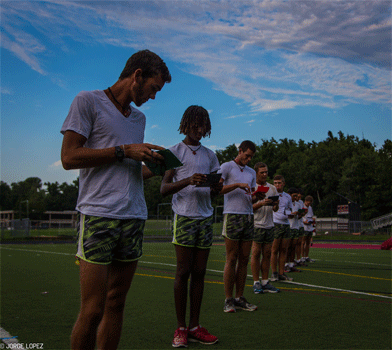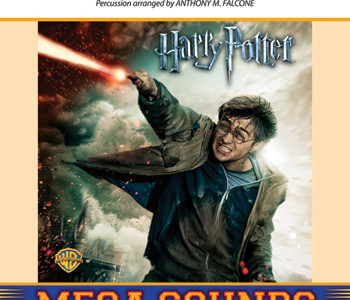From dot books to iPhone apps, the devices and methods for teaching drill have evolved and become more diverse. What’s the best method for you and your students?
Photo courtesy of Crossmen Drum and Bugle Corps.
If there is one thing that many band or corps members have to go through during the searing heat of the summer, it’s learning their drill. It’s the thing that attracts the most attention to fans and the judges in the stands. One miscalculation can become a glaring mistake in the middle of a show, possibly meaning the difference between winning and losing. No longer is drill simply just marching in a straight line or following the leader as drill has become more and more sophisticated. In order to have clean drill while incorporating complex forms with a higher level of expectation, new techniques are being developed that will shape how band and corps members learn their drill.
Dot Books
For many years, anybody learning drill would have a small notebook to plot their coordinates and figure out where they are supposed to be in relation to the hashes and the yard markers on the gridiron. Brooks Andersen, drill designer who works for Putnam City North High School in Oklahoma City, believes that having students copying and writing down their coordinates into a dot book emphasizes their awareness on the field.
“By having them copying down their dots, it makes them really look at where they are on the field in relation to the hashes and the lines as well as other [people],” Andersen says. “It can help with their field vision.”
Dan Ryder, owner of Dan Ryder Field Drills, uses map books when he works with various Texas high schools. This evolved version of dot books uses small maps of a few dots to show their students where to go.
“What is good about map books is that the band directors can see the drill from the students’ perspective when the students are making the maps, and they can see exactly how they are supposed to move on the field,” Ryder says. “With a few dots, the students can draw lines and arrows to help them visualize. The more information they have in their hands, the easier it is for them to understand the drill and learn it faster.”
Coordinate Sheets and Printouts
These days, however, many schools have discarded dot books in favor of printing coordinate sheets generated by software such as Pyware, Field Artist and EnVision. Using software helps streamline the process as coordinate sheets provide plots to tell students where they need to go.
“Our software enables bands to plan out their drill in a clean and organized fashion,” says Dustin Merrell, application systems director with Pyware. “It is so that the students have all the tools necessary to be successful at marching their spots.”
The level of precision, though, may differ between drum corps and high school marching bands. Brad Slusarczyk, visual caption head with the Crossmen Drum and Bugle Corps, has the corps members be as precise as they possibly can.
“When we are learning drill at the corps, we have it as precise as a quarter of a step,” Slusarczyk says. “When it comes to a high school band, it can differ depending on the maturity of the band. If the band is just starting to grasp the concept of step sizes, then the drill can go up to half steps. If the band has a good grasp of it, then they can be as precise as they possibly can.”
Some bands give full-sized printouts to every band member while other groups give them only to instructors. By only having the instructors and directors have the full-sized printouts, they are able to discern problems and troubleshoot them without any obstacles, Andersen says.
“By just having the staff have the drill printouts, they are able to clean it up from the box without having section leaders walking around,” Andersen says. “If that happens, it can get difficult for the staff to see if there is a problem in the form. We just tell them to get to their dots, stand feet together, and if there is anybody that’s lost, we can pluck them out and help them go where they need to be.”
Ryder concurs with Andersen. “Before the software with making coordinate sheets was available, students were given full-sized charts,” Ryder says. “It would show them where they would go from set to set and how they would get there. Now with coordinate sheets, there is no need for that.”
Going Digital
Now that many marching bands have been using software to make their coordinate sheets and printouts, technology is playing a big role. With the advent of the iPhone and the iPad, mobile apps can now be used to teach drill.
Stuart Bowman developed an app called DotBook, which is a 3D marching simulator that gives a full layout of the drill using a mobile device.
“During high school, we used a lot of paper dot books and such, which was a good tool, but there was no real way to visualize drill on a sheet of paper,” Bowman says. “There were some apps already out there at the time, but they were limited in terms of functionality as the view was flat and in 2D.”
Once he developed the app and released it, DotBook garnered a bit of interest, and Bowman’s friend who marches with Carolina Crown Drum and Bugle Corps began to use it to help with his drill.
“He missed some practices when he was with Crown as he was at home for his graduation,” Bowman says. “The staff sent him his drill coordinates, and using that he plotted his dots into the app, and he was able to see exactly where he needed to be. It was a very good tool for him to learn his drill when he missed rehearsals.”
The Pyware March Pad, a Dance Dance Revolution styled drill tool, also helps alleviate the problem of missed rehearsals. Students step on an interactive pad to practice their individual drill steps and directional changes. The tool has helped many ensembles, particularly the U.S. Army All-American Marching Band, learn its drill.
“The March Pad is able to help any marcher who has to miss practice be up to speed with their drill learning,” Merrell says. “With ensembles like the U.S. Army All-American Marching Band, they don’t have a lot of rehearsals where the whole band is together, so they use the March Pad to learn their drill at home, so when they go to their practices, they are ready to go.”
With the awe of technology, potential distractions can occur. Having a large amount of iPhones and iPads can become a director’s worst nightmare as students could do other things on those devices if they are not kept in check.
“I would be all for them on the field to help with drill as long as they are school-issued,” Andersen says. “If they’re school-issued, they can have locks put on them, so that only the necessary software can be accessed on the field. The last thing we need is to have people on the field texting and such.”
Ryder believes that the use of mobile apps will be the future of drill teaching. “I can see them being used on the field, and I am all for them,” Ryder says. “I want the students to have as much information as they can in their hands. As long as they put a lock on them, it can potentially be a very useful tool.”
Form vs. Dot
Even with various tools available, a debate has ensued among visual instructors about whether to teach the dot or teach the form. Slusarczyk believes that the dot should be taught first before form, but that form is ultimately what the judges see.
“We want our members to hit the dots and have the drill form itself through that fashion,” Slusarczyk says. “Ultimately, though, when a judge is looking at a band or a corps, the first thing they will see is the form, and if it doesn’t look right, it will reflect in the score.”
Ryder believes it depends on the maturity of the band. The skill level of the band members determine how they are able to be taught.
“If the band has a lot of young recruits that have never marched before, teaching the form would be too abstract of a concept for them to grasp,” Ryder says. “They need something a lot more concrete which is why teaching the dot should be done with them. Once the band understands the drill and how they move, they start reverting to the form. The bands that are most successful are the ones that use the concept of the dot as a teaching tool and then march the form once the dots are firmly in their heads.”


